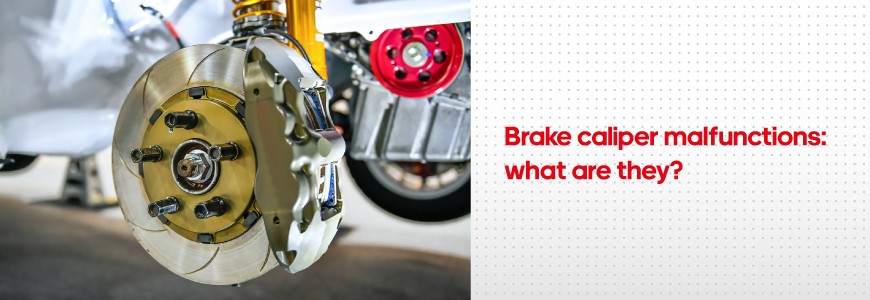
The brake caliper - part of the disc brake mechanism. Depending on the design, the brake calipers can be:
1) referring to the carrier mounting:
– with a fixed carrier;
– with a floating carrier.
2) referring to the piston quantity:
– single piston brake calipers;
– multi piston brake calipers.
3) referring to the axle of a car:
– for the front axle;
– for the rear axle with the parking brake mechanism.
Symptoms of the fault brake caliper
Car pulls to a side It's a result of the seizure of the front axle brake caliper when the wheel keeps braking.
Burning smell The rear brake caliper piston seizure causes the unpleasant burning smell. The driver may not notice that the car pulls a side, especially, if a car is a front wheel drive (FWD), and will keep driving at usual speed mode. At the same time, the rubbing pads would overheat and cause the burning smell.
Uncommon noise or knocking in the wheels while driving the uneven road. It usually happens due to the broken or loosen brake pad spring clips. That’s why the brake pads would develop the noise on any unevenness.
Uneven wear of the brake pads on one car axle. The visible uneven wear of pads on one axle is a sign of a malfunction of one of the brake calipers.
Brake fluid leakage. The wet oily spot near the wheel after parking may inform about the brake caliper leaking.
Brake caliper failure reasons
The brake calipers are affected by the significant temperature shock and are exposed to the negative influence of environment: dirt, dust, moisture and chemicals. That means the the main failure reason - the heavy operation conditions of the assembly that may lead to the dust boot damages, the washing out of the lubricant from the brake caliper guides and to the corrosion.
Another reason of the brake caliper failure - the lack of the proper maintenance: the lubrication of the brake caliper guides and the replacement of the brake fluid. All the brake fluids are hygroscopic, meaning they easily absorb the moisture from the air. The water in the brake fluid causes the piston corrosion and the inner surfaces of brake caliper body. It leads to the early wear of the seals and to the leakage.
How to check the brake calipers?
The brake caliper can be inspected without its disconnection from the hydraulic system. Although they have to be dismounted from the wheel hub or the steering knuckle.
First, inspect the brake calipers visually. Check if the fluid flow marks are absent and the dust boots are not damaged. Then press the piston, it has to go down without efforts. Next. check if the brake caliper carrier moves smoothly. If the brake caliper is equipped with the parking brake mechanical mechanism, check if it moves smoothly.
Brake caliper reliability.
No matter what the configuration is of the brake calipers, they are equally reliable in the same operation conditions. The average life span of the brake calipers is around 7-8 years, then you should replace all the rubber components, and the brake calipers may again operate the same period.
Repair, or new brake calipers?
You’ll have the answer to this question only when you disassemble the brake caliper and examine the damage level. The repair will be reasonable if it includes only the cleaning, lubricating of the calipers and the replacement of the seals and dust boots. This repair would be less expensive than the price of a new caliper, although the life span would be almost the same.
Important point! Don’t count on the proper repair in a garage. The repair of the brake calipers will be efficient only if you address the specialized car service center that has the appropriate equipment and the spare parts provided by the reliable suppliers. Besides, nowadays, ‘repair to exchange” is getting more popular. It costs a bit more than a common repair, yet you get the serviceable brake caliper with a warranty at once.



COMMENTS